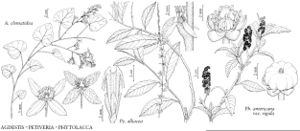Petiveria alliacea
Sp. Pl. 1: 342. 1753.
Stems erect, 3–20 dm, pubescent to glabrate. Leaves: stipules 2 mm; petiole 0.4–2 cm; blade elliptic to oblong or obovate, to 20 × 7 cm, base acute to cuneate, apex acuminate or acute to obtuse or rounded. Inflorescences often drooping distally, 0.8–4 dm; peduncle 1–4 cm; pedicel 0.5–2 mm. Flowers slightly imbricate to rather remote; sepals white or greenish to pinkish, linear-lanceolate to linear-oblong, 3.5–6 mm; ovary tomentose. Achenes striate, subtended by persistent bracts and perianth, ± appressed to rachis, 8–12 mm. 2n = 36, 72.
Phenology: Flowering year-round southward, spring–fall northward.
Habitat: Orchards, woods, hammocks, thickets, middens, clearings
Elevation: 0-40 m
Distribution
Fla., Tex., Mexico, warm regions of the New World.
Discussion
J. W. Nowicke (1968) called plants with “4-hooked” fruits var. alliacea, those with “3- or 6-hooked” fruits, var. tetrandra (Gomez) Nowicke. This distinction fails in the flora area.
The leaves of Petiveria alliacea have an alliaceous odor when crushed. The plant taints the milk and meat of animals that graze on it and may also induce abortion. In some areas of tropical America, it serves as a vampire repellent of unrecorded efficacy.
Selected References
None.
